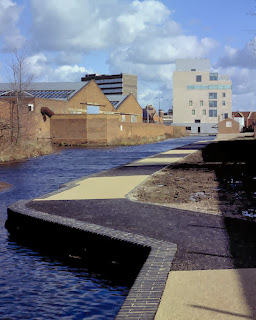The subject of the point of view of a photograph
and what sets out the photographers vantage point of his subject is one which I
find intriguing. Many images of famous places and cities are often reproductions
of an original, set out by some postcard portraiture ideal however do they
really give us a sense of place of what they are describing or simply form a
pleasant image.
Denis Gilbert recently commented on the disposable nature of digital photography in today's age and how thousands of images can be recorded in a day's work compare to 15 or 20 considered frames of film which are then carefully developed into the finished image. In a profession such as architectural photography the photographer wants to give the viewer a sense of the place which they are looking at without them actually having to go there. How many photographs are necessary to do this? Eugene Atget dedicated the better portion of his life capturing the sense and atmosphere of pre revolution Paris before it was lost forever. Publications such as el Croquis spend a number of days in any one place capturing the sense of place of award winning architecture. What if any is the difference between what the photographer is trying to show us and what the architect is trying to tell us about a work. Can revisiting a project through the unbiased eyes of a new photographer be of advantage to future work.
Based in Madrid El Croquis is a magazine which has been operating since 1982 displaying the works of various award winning architects. Their editions dedicated to Norman Foster, Rafael Moneo and Sanaa can be considered to be the oeuvre complete of these architects and great prestige is attached to an office having a Croquis based on their own work.
El Croquis which translates to English as "the sketch" operate as their name suggests by delivering a quick overview of the office they are examining. They work very quickly travelling as a small group to conduct interviews with the architects and also examine the architect's work. They are very consistent in the quality of their output providing an unbiased first glance of the work of a firm which they feel convey their central style or themes. Using a large format film camera their photographer Hisao Suzuki makes all original photographs for use in each publication. Transforming their hotel room into their mobile office/dark room they produce a completely original and independent dossier of work on the architects.
In 2013 El Croquis published their 166th edition with the work of London based architects Caruso St John as their subjects. Their New Gallery in Walsall England featured in this edition and is an interesting example of an architect's point of their own project versus the fresh point of view of the Croquis photographer Hisao Suzuki. There is a gap of almost 13 years between when the building was completed and when the Croquis team visited so an interesting comparison may be observed.
The building itself sits in a rough austere environment flanked by dilapidated factories and a canal recalling a more prosperous time. It asserts itself as a tower among the rusted buildings feathered in green terracotta tiles the project being conceived as a model of quality and good practice about which the rest of the town could evolve.
The tower is presented by Croquis in punchy juxtaposition with its context, the dilapidated factories providing an almost cultural background to the character of the town. Then Suzuki moves closer displaying the building in its more immediate setting with its modern shopping squares and its metropolitan cafés. Immediately the intention of the project is made clear. Then we are transported inside and are flooded with information on surface materiality and light. Suzuki has carefully considered each photograph as to maximise the information presented in an image. Suzuki takes long exposures creating saturating the images in the gallery spaces natural light and giving a great sense of embodiment and atmosphere to the photographs as blurred figures occasionally move through. Photographing stairways and circulation corridors instils in us a sense of movement and the entire series of photographs give a sense of a journey moving closer into and around the building. The final photograph gives a great sense of closure viewing out a window connecting back on the landscape where the journey had begun.
Croquis' method of concisely summing up the work of Caruso St John in this instance has led the firm to use many of the images in their own publication of the building on their website after the book was released. Having previously relied on largely pictorial renders and architectural drawings to describe the work it is certainly a compliment to the work of Suzuki and the Croquis team.



No comments:
Post a Comment